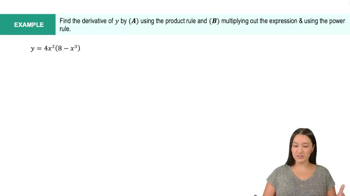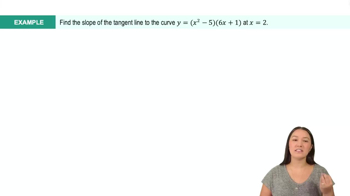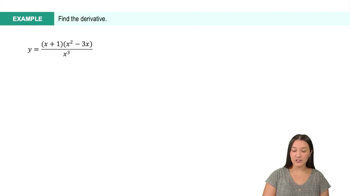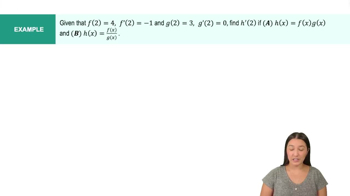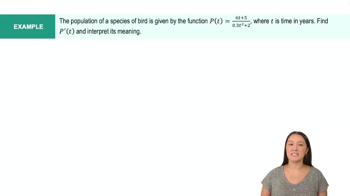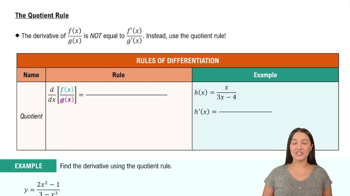Table of contents
- 0. Functions7h 52m
- Introduction to Functions16m
- Piecewise Functions10m
- Properties of Functions9m
- Common Functions1h 8m
- Transformations5m
- Combining Functions27m
- Exponent rules32m
- Exponential Functions28m
- Logarithmic Functions24m
- Properties of Logarithms34m
- Exponential & Logarithmic Equations35m
- Introduction to Trigonometric Functions38m
- Graphs of Trigonometric Functions44m
- Trigonometric Identities47m
- Inverse Trigonometric Functions48m
- 1. Limits and Continuity2h 2m
- 2. Intro to Derivatives1h 33m
- 3. Techniques of Differentiation3h 18m
- 4. Applications of Derivatives2h 38m
- 5. Graphical Applications of Derivatives6h 2m
- 6. Derivatives of Inverse, Exponential, & Logarithmic Functions2h 37m
- 7. Antiderivatives & Indefinite Integrals1h 26m
- 8. Definite Integrals4h 44m
- 9. Graphical Applications of Integrals2h 27m
- 10. Physics Applications of Integrals 2h 22m
3. Techniques of Differentiation
Product and Quotient Rules
Problem 94
Textbook Question
Given that p(x) = (5e^x+10x⁵+20x³+100x²+5x+20) ⋅ (10x⁵+40x³+20x²+4x+10), find p′(0) without computing p′(x).
 Verified step by step guidance
Verified step by step guidance1
Step 1: Recognize that p(x) is a product of two functions, say f(x) = 5e^x + 10x^5 + 20x^3 + 100x^2 + 5x + 20 and g(x) = 10x^5 + 40x^3 + 20x^2 + 4x + 10.
Step 2: Use the product rule for differentiation, which states that if p(x) = f(x)g(x), then p'(x) = f'(x)g(x) + f(x)g'(x).
Step 3: Evaluate f(0) and g(0) by substituting x = 0 into f(x) and g(x).
Step 4: Find f'(0) and g'(0) by differentiating f(x) and g(x) and then substituting x = 0 into the derivatives.
Step 5: Substitute f(0), g(0), f'(0), and g'(0) into the product rule expression for p'(0) to find the value of p'(0).
 Verified video answer for a similar problem:
Verified video answer for a similar problem:This video solution was recommended by our tutors as helpful for the problem above
Video duration:
8mPlay a video:
Was this helpful?
Key Concepts
Here are the essential concepts you must grasp in order to answer the question correctly.
Product Rule
The Product Rule is a fundamental principle in calculus used to differentiate the product of two functions. It states that if you have two functions, u(x) and v(x), the derivative of their product is given by p'(x) = u'(x)v(x) + u(x)v'(x). This rule is essential for finding the derivative of p(x) without directly computing p'(x).
Recommended video:
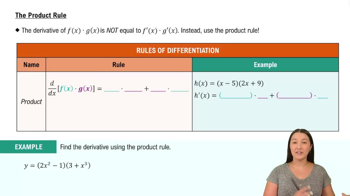
The Product Rule
Evaluating Derivatives at a Point
To find p′(0), we need to evaluate the derivative of p(x) at x = 0. This involves substituting x = 0 into the derivative expression obtained from the Product Rule. Understanding how to evaluate functions and their derivatives at specific points is crucial for solving problems that require finding instantaneous rates of change.
Recommended video:

Critical Points
Exponential and Polynomial Functions
In the given function p(x), we have both exponential (e^x) and polynomial terms (like 10x⁵ and 20x³). Knowing how to differentiate these types of functions is vital, as they behave differently under differentiation. Exponential functions grow rapidly, while polynomial functions have a more predictable growth pattern, which influences the overall behavior of p(x) and its derivative.
Recommended video:
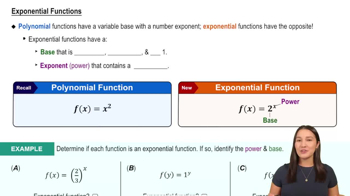
Exponential Functions
Related Videos
Related Practice



